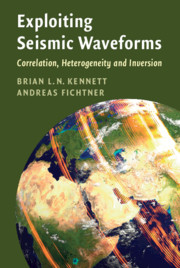
-
Select format
-
- Publisher:
- Cambridge University Press
- Publication date:
- November 2020
- December 2020
- ISBN:
- 9781108903035
- 9781108830744
- 9781108828789
- Dimensions:
- (247 x 174 mm)
- Weight & Pages:
- 1.09kg, 504 Pages
- Dimensions:
- (247 x 174 mm)
- Weight & Pages:
- 0.96kg, 502 Pages
You may already have access via personal or institutional login
Book description
Exploiting Seismic Waveforms introduces a range of recent developments in seismology including the application of correlation techniques, understanding of multi-scale heterogeneity and the extraction of structure and source information by seismic waveform inversion. It provides a full treatment of correlation methods for seismic noise and event signals, and develops inverse methods for both sources and structure. Higher frequency components of seismograms are frequently neglected, or removed by filtering, but they contain information about seismic structure on scales that cannot be revealed by seismic tomography. Sufficient computational resources are now available for waveform inversion for 3-D structure to be a practical procedure and this book describes suitable algorithms and examples reflecting current best practice. Intended for students and researchers in seismology, this book provides a physical understanding of seismic waveforms and the way that different aspects of the seismic wavefield are revealed by the way that seismic data are handled.
Reviews
‘The authors of this volume are recognized internationally for their many fundamental contributions to global and exploration geophysics. They have succeeded admirably in producing a volume that straddles both disciplines and commenting on the often-ignored relationships and differences between them. Exploiting Seismic Waveforms is bound to become a standard reference in both theoretical and computational seismology. The theory is presented with the eloquence and crispness we have already known to be associated with previous writings by these two authors. Allow me therefore … to grade this beautiful volume with an A+.’
Sven Treitel - The Leading Edge
Contents
Metrics
Altmetric attention score
Full text views
Full text views help Loading metrics...
Loading metrics...
* Views captured on Cambridge Core between #date#. This data will be updated every 24 hours.
Usage data cannot currently be displayed.
Accessibility standard: Unknown
Why this information is here
This section outlines the accessibility features of this content - including support for screen readers, full keyboard navigation and high-contrast display options. This may not be relevant for you.
Accessibility Information
Accessibility compliance for the PDF of this book is currently unknown and may be updated in the future.


